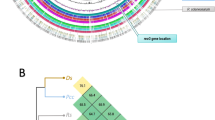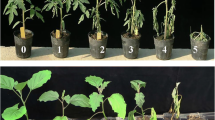Abstract
Biosensing diagnostic tools require biorecognition elements to precisely identify the causative pathogen, and the effectiveness of these devices is highly dependent on their biorecognition capabilities. In this study, we demonstrate the identification of a highly specific single-stranded DNA probe sequence (lpxC4) to be used as a universal biorecognition element toward the development of biosensing platforms for early detection of a soil-borne agricultural pathogen Ralstonia solanacearum. We have collected and studied 8 isolates of R. solanacearum infecting solanaceous vegetables from different parts of India as potential targets of this biorecognition element. The pathogenicity study on these isolates revealed their disease-causing abilities on eggplant. The extracted genomic DNA from the isolates were amplified using polymerase chain reaction and stored as the potential targets for further studies. Isolation of DNA targets from multiple strains and the identified DNA probe served as the foundation for develo** various biosensing platforms for detecting plant pathogens.






Similar content being viewed by others
References
Smith EF (1896) A bacterial disease of the tomato, eggplant, and Irish potato (Bacillus solanacearum nov. sp.). U.S. Dept. Agric. Div. Veg. Phys. Path. Bull. 12:1–26
Bessey C (1914) Bacteria in relation to plant diseases. Science 40(1037):715–715
Yabuuchi E, Kosako Y, Yano I, Hotta H, Nishiuchi Y (1995) Transfer of two burkholderia and An Alcaligenes species to Ralstonia gen. nov. Microbiol Immunol 39(11):897–904
Mansfield J, Genin S, Magori S, Citovsky V, Sriariyanum M, Ronald P et al (2012) Top 10 plant pathogenic bacteria in molecular plant pathology. Mol Plant Pathol 13(6):614–629
Salanoubat M, Genin S, Artiguenave F, Gouzy J, Mangenot S, Arlat M et al (2002) Genome sequence of the plant pathogen Ralstonia solanacearum. Nature 415(6871):497–502
Tsuchiya K (2004) Molecular biological studies of Ralstonia solanacearum and related plant. J Gen Plant Pathol 70(6):385–387
Buddenhagen I, Kelman A (1964) Biological and physiological aspects of bacterial wilt caused by Pseudomonas Solanacearum. Annu Rev Phytopathol 2(1):203–230
Xue Q, Yin Y, Yang W, Heuer H, Prior P, Guo J et al (2011) Genetic diversity of Ralstonia solanacearum strains from China assessed by PCR-based fingerprints to unravel host plant- and site-dependent distribution patterns. FEMS Microbiol Ecol 75(3):507–519
Meng F (2013) Ralstonia solanacearum species complex and bacterial wilt disease. J Bacteriol Parasitol. https://doi.org/10.4172/2155-9597.1000e119
Khater M, de la Escosura-Muñiz A, Merkoçi A (2017) Biosensors for plant pathogen detection. Biosens Bioelectron 93:72–86
Fang Y, Ramasamy R (2015) Current and prospective methods for plant disease detection. Biosensors 5(3):537–561
Achari G, Ramesh R (2018) Colonization of eggplant by endophytic bacteria antagonistic to Ralstonia solanacearum, the bacterial wilt pathogen. Proc Natl Acad Sci India Sect B Biol Sci 89(2):585–593
Ramesh R, Achari GA, Gaitonde S (2014) Genetic diversity of Ralstonia solanacearum infecting solanaceous vegetables from India reveals the existence of unknown or newer sequevars of Phylotype I strains. Eur J Plant Pathol 140:543–562. https://doi.org/10.1007/s10658-014-0487-5
Hayward A (1991) Biology and epidemiology of bacterial wilt caused by Pseudomonas solanacearum. Annu Rev Phytopathol 29(1):65–87
Kumar A, Prameela T, Suseelabhai R, Siljo A, Anandaraj M, Vinatzer B (2014) Host specificity and genetic diversity of race 4 strains of Ralstonia solanacearum. Plant Pathol 63(5):1138–1148
Chao J, Zhu D, Zhang Y, Wang L, Fan C (2016) DNA nanotechnology-enabled biosensors. Biosens Bioelectron 76:68–79
Wang Q, Wang J, Huang Y, Du Y, Zhang Y, Cui Y et al (2022) Development of the DNA-based biosensors for high performance in detection of molecular biomarkers: more rapid, sensitive, and universal. Biosens Bioelectron 197:113739
Vizzini P, Iacumin L, Comi G, Manzano M (2017) Development and application of DNA molecular probes. AIMS Bioeng 4(1):113–132. https://doi.org/10.3934/bioeng.2017.1.113
Rashid J, Yusof N (2017) The strategies of DNA immobilization and hybridization detection mechanism in the construction of electrochemical DNA sensor: a review. Sens Bio Sens Res 16:19–23
Acknowledgements
This work was financially supported by the India–Trento Program for Advanced Research (ITPAR—IV) joint project in the field of agricultural research through Department of Science and Technology (DST), Government of India. The first author would like to thank DST, Government of India, for the Ph.D. INSPIRE fellowship.
Funding
DST INSPIRE, Government of India, IF180964, Rhea Patel, ITPAR 4, DST, India.
Author information
Authors and Affiliations
Corresponding author
Ethics declarations
Conflict of interest
The authors declare that they have no conflict of interest.
Additional information
Publisher's Note
Springer Nature remains neutral with regard to jurisdictional claims in published maps and institutional affiliations.
Significance Statement: Identification of a highly specific single-stranded DNA probe sequence (lpxC4) to be used as a universal biorecognition element towards the development of biosensing platforms for early detection of a soil-borne pathogen Ralstonia solanacearum. We have studied 8 isolates of R. solanacearum from different parts of India as potential targets.
Rights and permissions
Springer Nature or its licensor (e.g. a society or other partner) holds exclusive rights to this article under a publishing agreement with the author(s) or other rightsholder(s); author self-archiving of the accepted manuscript version of this article is solely governed by the terms of such publishing agreement and applicable law.
About this article
Cite this article
Patel, R., Vinchurkar, M., Patkar, R. et al. Identification, Characterization, Isolation, and Pathogenicity Study of Ralstonia solanacearum: Foundation for Development of a Highly Selective DNA-Biosensing Platform. Proc. Natl. Acad. Sci., India, Sect. B Biol. Sci. 93, 595–601 (2023). https://doi.org/10.1007/s40011-023-01464-5
Received:
Revised:
Accepted:
Published:
Issue Date:
DOI: https://doi.org/10.1007/s40011-023-01464-5




